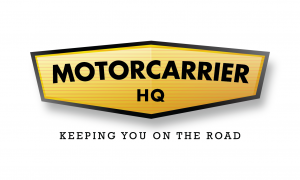April 18, 2023
How To Start A Trucking Company With One Truck

A Step-by-Step Guide to Starting a Trucking Business
All trucking businesses start somewhere — and many of them have small beginnings. It’s not uncommon to have one driver, one truck, and one employee (you). But you can grow those numbers pretty quickly if you build your business on the right foundation.
In fact, Motor Carrier HQ owner, Chris Vernon, specifically started his own one-man trucking company “Haulin Assets” to show other fleet drivers looking to make the jump to owner-operator exactly what they need to do to be successful. He’s overcome many challenges on his journey to grow Haulin Assets from a one-truck business into the successful ten-truck fleet that it is today — all of which are recorded on the Haulin Assets podcast.
We know firsthand how hard it can be to shoulder the responsibilities of an owner-operator, especially when you’re starting out as a one-truck business. That’s why we’ve created this step-by-step guide to starting a trucking business.
Read on to learn the four key steps you need to take to get your business up and running!
1. Establish Your Business Plan
The very first thing every aspiring owner-operator should do is develop a solid business plan. A business plan helps you put pen to paper and figure out what tangible success could look like for you. Part of the plan will include the ‘big picture’ details of your business such as your vision and mission while other plan items will be more specific and fact-based, such as determining how to clearly track profit and loss.
Here are a few key questions you’ll want to explore as you create your business plan:
- What’s your goal with this company?
- What type of freight do you plan on hauling? Is the market strong for that type of freight in you area?
- How do you differ from the competition?
- How much funding do you need to start? How much will your funding needs change a year from now?
- What amount of work can you take on with one truck?
- Do you want to lease or own your truck?
- How much money do you want to make each year?
- What will business growth look like and how will you measure success?
- What skills do you have to promote your business and what gaps in skills do you need to fill?
- How will you start with limited cash flow and do you know how to get startup money?
- Who are your customers? Who do you consider to be part of your professional network as a small business owner? And how can you leverage your network?
- What deadline will you set for yourself to complete all your licensing and registration requirements before getting on the road?
- How do you want to manage your business?
- How often will you update this business plan?
2. Choose the Right Business Entity for You
As you create your business plan, one of the most important things to determine is what type of business entity you’re going register as with your state and what type of business entity you want to be recognized as with the IRS, they don’t always have to match up. You can be a sole proprietorship, a partnership, C corporation, an S corporation, or a limited liability company (LLC), to name a few of the most common.
Each of these types of business entities have different tax requirements and legal capabilities. There are pros and cons to each entity type, so it’s best to consult with a tax advisor or other type of legal professional who is familiar with the various entity types and associated laws. They can help you determine which type of entity will be most beneficial for you moving forward.
Once you’ve selected your entity type and filed the appropriate paperwork to establish your business with the IRS, you can register your business with the Federal Motor Carrier Safety Administration (FMCSA) and complete the rest of the paperwork steps.
3. Research Dispatchers to Start Hauling Loads
Once you’ve registered your business and received all of the certifications to be cleared to operate, your next challenge will be finding enough work to make sure your business is profitable. An easy way to do this is to work with a dispatcher.
Dispatchers often have relationships with shippers and brokers and can help you find jobs. They usually know how to navigate the difficult world of finding companies that will work with a brand-new carrier. Working with a dispatcher means you won’t have to worry about searching out your own hauls; they will do all of the work to find the loads and supply you with all of the relevant information like the type of freight you’d be hauling, where it needs to go, and when it has to arrive by. As an independent company, you then get to choose where you want to drive and what loads you’re comfortable with. This can be really helpful if you’re just starting out and working to build your reputation and your network.
When deciding what dispatcher to work with, it’s important to look at their reputation. Do they consistently have loads for the carriers they work with? How long have they been established? What do other owner-operators have to say about working with them? If you don’t want to haul jobs for a shipper or broker that doesn’t pay on time or has a reputation for being unreliable and unfair, a dispatcher can often help you avoid bad companies. They will help you avoid the type of risk that can have devastating consequences if things go sideways.
If you don’t want to use a dispatcher, you can find loads on your own by using load boards and developing your own network of shippers and brokers. That’s usually a more challenging path when you are just getting started.
4. Secure Your Most Important Piece of Equipment: a Truck
As an owner-operator, you’re now a small business owner who is responsible for providing your own equipment and supplies — and that includes a truck. You can choose to lease a truck through a carrier, though it comes with its own advantages and disadvantages, so be sure to weigh your options carefully.
If you decide to purchase a truck, the main goal is to control your costs as much as possible. A new commercial truck usually starts well over $100,000, which usually requires some sort of loan or financial plan to secure. While it’s common to take out loans from a trucking-specific finance company, it’s a big decision.
Not every business owner has the capital available to invest in a brand-new rig when they’re starting out, which is why buying a used rig can be a great option for new owner-operators. Be sure to learn as much as you can about the truck, like who owned it previously, how it was cared for, if regular maintenance was performed on time if it needed any major repairs, etc. Be patient and don’t rush the decision. You can use this helpful spreadsheet from Motor Carrier HQ to help you compare your options.
It’s also important to make sure you’re charging a competitive enough rate in your business to ensure you’re using your equipment in the most profitable way. Before you haul a load, for example, you can check on how much you’re projected to make by the end and how much you may have to spend to get the job done. Make sure you thoroughly vet potential loads and avoid those that are at a high risk of being unprofitable. The last thing your business needs is to take a big hit when it’s just starting to hit the road. You can learn more about vetting loads by listening to this podcast episode.
If you feel overwhelmed, just remember you’ve got thousands of owner-operators to learn from! Whether you meet them on the job or become part of the Motor Carrier HQ community, there are many other drivers who have been right where you are now. Make sure to check out the Haulin’ Assets podcast (we release two new episodes every month!) to hear more about the finances, the stories, and the how-tos for being an owner-operator, as well as some of the pitfalls to avoid along the road to success.


